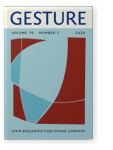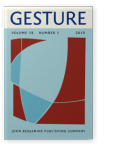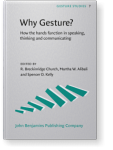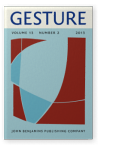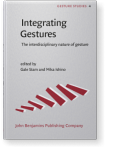Mitchell J. Nathan
List of John Benjamins publications for which Mitchell J. Nathan plays a role.
2020 Learning from an avatar video instructor: The role of gesture mimicry Gesture 19:1, pp. 128–155 | Article
Teachers often produce gestures, and, in some cases, students mimic their teachers’ gestures and adopt them into their own repertoires. However, little research has explored the role of gesture mimicry in technology-based learning contexts. In this research, we examined variations in the rate… read more
2019 Teachers’ attitudes about gesture for learning and instruction Gesture 18:1, pp. 31–56 | Article
We developed and tested a survey instrument to measure teachers’ attitudes about gesture in learning and instruction (TAGLI). Teachers (N = 192) generally believed that instructional gestures are beneficial for learning, and not distracting for students. Teachers had positive expectations, both… read more
2017 Chapter 8. One function of gesture is to make new ideas: The action-cognition transduction hypothesis Why Gesture?: How the hands function in speaking, thinking and communicating, Church, Ruth Breckinridge, Martha W. Alibali and Spencer D. Kelly (eds.), pp. 175–196 | Chapter
Abstract
I propose that gestures and actions create ideas through action-cognition transduction, whereby actions predictably induce cognitive states in a fashion reciprocal to ways that cognition drives action. The action-cognition transduction hypothesis challenges classical… read more
2017 Chapter 13. Making and breaking common ground: How teachers use gesture to foster learning in the classroom Why Gesture?: How the hands function in speaking, thinking and communicating, Church, Ruth Breckinridge, Martha W. Alibali and Spencer D. Kelly (eds.), pp. 285–316 | Chapter
Abstract
Teachers regularly use gesture as part of multimodal instruction to both break and make common ground. Teachers break common ground when they introduce new ideas and new mathematical practices. Teachers make common ground by connecting new ideas to students’ prior… read more
2013 Students learn more when their teacher has learned to gesture effectively Gesture 13:2, pp. 210–233 | Article
Teachers’ gestures are an integral part of their instructional communication. In this study, we provided a teacher with a tutorial about ways to use gesture in connecting ideas in mathematics instruction, and we asked the teacher to teach sample lessons about slope and intercept before and after… read more
2011 Chapter 19. How gesture use enables intersubjectivity in the classroom Integrating Gestures: The interdisciplinary nature of gesture, Stam, Gale and Mika Ishino (eds.), pp. 257–266 | Chapter
In communication it is essential for speaker and listener to establish intersubjectivity, or “common ground.” This is especially true in instructional settings where learning depends on successful communication. One way teachers enable intersubjectivity is through the use of gestures. We consider… read more
